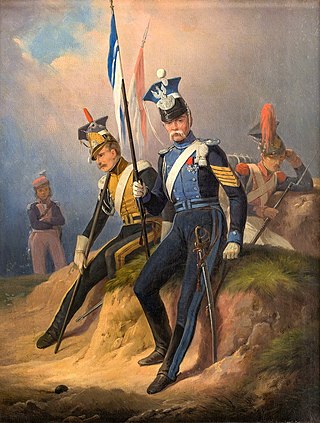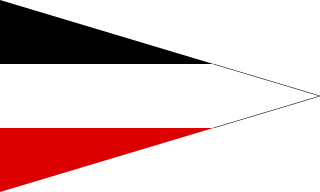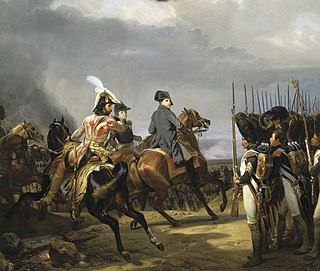This article has multiple issues. Please help improve it or discuss these issues on the talk page . (Learn how and when to remove these template messages)
|
The following units and commanders fought in the Battle of Rain.
This article has multiple issues. Please help improve it or discuss these issues on the talk page . (Learn how and when to remove these template messages)
|
The following units and commanders fought in the Battle of Rain.
John Tserclaes, Count of Tilly

Dragoons were originally a class of mounted infantry, who used horses for mobility, but dismounted to fight on foot. From the early 17th century onward, dragoons were increasingly also employed as conventional cavalry and trained for combat with swords and firearms from horseback. While their use goes back to the late 16th century, dragoon regiments were established in most European armies during the 17th and early 18th centuries; they provided greater mobility than regular infantry but were far less expensive than cavalry.

Cuirassiers were cavalry equipped with a cuirass, sword, and pistols. Cuirassiers first appeared in mid-to-late 16th century Europe as a result of armoured cavalry, such as men-at-arms and demi-lancers, discarding their lances and adopting the use of pistols as their primary weapon. In the later part of the 17th century the cuirassier lost his limb armour and subsequently wore only the cuirass, and sometimes a helmet. By this time, the sword or sabre had become his primary weapon, with pistols relegated to a secondary function.

The Battle of Breitenfeld or First Battle of Breitenfeld, was fought at a crossroads near Breitenfeld approximately 8 km north-west of the walled city of Leipzig on 17 September, or 7 September, 1631. It was the Protestants' first major victory of the Thirty Years' War.

Uhlans were a type of light cavalry, primarily armed with a lance. While first appearing in the cavalry of Lithuania and then Poland, Uhlans were quickly adopted by the mounted forces of other countries, including France, Russia, Prussia, Saxony and Austria-Hungary.

The Battle of Fleurus of August 29, 1622 was fought in the Spanish Netherlands between a Spanish army, and the Protestant forces of Ernst von Mansfeld and Christian of Brunswick during the Eighty Years' War and Thirty Years' War. The bloody struggle left the Protestants mangled and the Spanish masters of the field and would ensure Catholic dominance in Germany till the intervention of Denmark–Norway.
The Cuirassier Regiment "Queen" (Pomeranian) No. 2 was a Prussian cavalry regiment. Formed in 1717 as Dragoner-Regiment Nr.5 Bayreuth Dragoner it was originally a dragoon regiment and was part of the Prussian order of battle until 1918. The Bayreuth Dragoons achieved fame for their role in winning the Battle of Hohenfriedberg in 1745. In 1819 it was transformed into a cuirassier regiment.

The Battle of Soor was a battle between Frederick the Great's Prussian army and an Austro-Saxon army led by Prince Charles Alexander of Lorraine during the Second Silesian War. The battle occurred in the vicinity of Soor, also known as Hajnice, in the modern day Czech Republic. The battle started with a failed Austrian surprise attack on the outnumbered Prussians. Despite initial setbacks the Prussian army managed to defeat the Austrians, due to an unexpected attack from a reserve regiment that refused to follow Frederick's orders.

The Guards Cavalry Division (Garde-Kavallerie-Division) was a unit of the Prussian Army that was stationed in Berlin. The division was a part of the Guards Corps (Gardekorps).

The following units and commanders fought in the Battle of Breitenfeld of the Thirty Years War in 1631. Unless otherwise noted, all units have ten companies.

The Battle of Lübeck took place on 6 November 1806 in Lübeck, Germany between soldiers of the Kingdom of Prussia led by Gebhard Leberecht von Blücher, who were retreating from defeat at the Battle of Jena–Auerstedt, and troops of the First French Empire under Marshals Murat, Bernadotte, and Soult, who were pursuing them. In this War of the Fourth Coalition action, the French inflicted a severe defeat on the Prussians, driving them from the neutral city. Lübeck is an old Baltic Sea port approximately 50 kilometres (31 mi) northeast of Hamburg.

In the Battle of Prenzlau or Capitulation of Prenzlau on 28 October 1806 two divisions of French cavalry and some infantry led by Marshal Joachim Murat intercepted a retreating Prussian corps led by Frederick Louis, Prince of Hohenlohe-Ingelfingen. In this action from the War of the Fourth Coalition, Hohenlohe surrendered his entire force to Murat after some fighting and a parley. Prenzlau is located about 90 kilometers north of Berlin in Brandenburg.

The Jena-Auerstedt campaign order of battle is listed below. The order of battle includes units from the First French Empire and the Kingdom of Prussia that fought each other in the campaign that included the decisive Battle of Jena-Auerstedt on 14 October 1806. The order of battle may be useful to trace the battles of Schleiz and Saalfeld, which occurred before Jena-Auerstedt, as well as battles and capitulations that happened after 14 October, such as Erfurt, Halle, Prenzlau, Pasewalk, Stettin, Waren-Nossentin, and Lübeck.
The II Cavalry Corps of the Grande Armée was a French military unit that existed during the Napoleonic Wars. It was first formed in December 1806, but only enjoyed a brief existence under Marshal Jean-Baptiste Bessières. The II Cavalry Corps was reconstituted for the invasion of Russia in 1812 and commanded by General Louis-Pierre Montbrun who was killed in battle, as was his successor a few hours later. During the War of the Sixth Coalition, General Horace François Bastien Sébastiani de La Porta led the II Cavalry Corps in 1813, while General Antoine-Louis Decrest de Saint-Germain led the corps in 1814. During the Hundred Days, Emperor Napoleon Bonaparte raised the corps again and entrusted it to General Rémi Joseph Isidore Exelmans.

The 6th Cavalry Division was a unit of the German Army that fought on Eastern and Western Fronts during World War I. The division was formed on the mobilization of the German Army in August 1914 and was disbanded in 1919 during the demobilization of the German Army after World War I.

The regiment was a cavalry unit raised in the 17th century for the Imperial Habsburg Army. Over the course of time, this unit became the 8th Bohemian Dragoons (Count Montecuccoli's) (Böhmischen Dragoner-Regiment „Graf Montecuccoli“ Nr. 8) within the "Common Army" that formed part of the Austro-Hungarian Army. From 1888 the unit was to bear this new title "in perpetuity".
The III Cavalry Corps of the Grande Armée was a French military unit that existed during the Napoleonic Wars. The corps was created in 1812 and reconstituted in 1813 and 1815. Emperor Napoleon Bonaparte first mobilized the corps for the invasion of Russia. Commanded by General Emmanuel de Grouchy, two divisions of the corps fought at Borodino, Tarutino, and Vyazma. A third division fought at the First and Second battles of Polotsk and the Berezina. During the War of the Sixth Coalition in 1813, General Jean-Toussaint Arrighi de Casanova led the corps at Großbeeren, Dennewitz, Leipzig, and Hanau.
The Reserve Cavalry Corps or Cavalry Reserve of the Grande Armée was a French military unit that existed during the Napoleonic Wars. In 1805, Emperor Napoleon Bonaparte appointed Marshal Joachim Murat to command all the cavalry divisions that were not directly attached to the army corps. During the Ulm campaign, Murat led his horsemen in successfully hunting down many Austrian units that escaped the capitulation of Ulm, before fighting at Austerlitz in December 1805. Under Murat, the Cavalry Reserve played a prominent role in the destruction of the Prussian armies after the Battle of Jena-Auerstedt in 1806. In 1812, the Reserve Cavalry Corps was split up into the I, II, III, and IV Cavalry Corps for the French invasion of Russia.

The siege of Landau saw an army from the Holy Roman Empire led by Louis William, Margrave of Baden-Baden lay siege to the fortress city of Landau which was held for the Kingdom of France. The French defenders led by Ezéchiel du Mas, Comte de Mélac resisted vigorously but were forced to surrender after a three-month leaguer. This action of the War of the Spanish Succession occurred at Landau in the state of Rhineland-Palatinate, Germany, located 49 kilometres (30 mi) southwest of Mannheim.

Armour in the 18th century was minimalist and restricted almost entirely to cavalry, primarily to cuirassiers and, to a lesser degree, carabiniers and dragoons. Armour had been in rapid decline since the Thirty Years' War, although some archaisms had lingered on into the early years of the 18th century, like Austrian cuirassiers with buff coats and lobster-tailed helmets or Hungarian warriors with mail armour and shields. With the exception of Poland-Lithuania, which still made use of hussars wearing suits of plate armour, armour in Europe was primarily restricted to a breast- and backplate, the cuirass, and a simple iron skull cap worn under the hat. By the later 18th century, there were two contradicting developments. Many cuirassier regiments were discarding their cuirasses, while helmets in the form of so-called dragoon helmets, made of brass or leather, made a comeback among the cavalry and infantry.
The Second Battle of Breitenfeld was a major engagement of the Thirty Years' War between the Imperial Army of the Holy Roman Empire under Archduke Leopold Wilhelm of Austria and Ottavio Piccolomini, supported by Saxon troops, and the Swedish Army under Lennart Torstensson. It was the last battle of the war featuring more than 20.000 soldiers on each side and one of the rare occasions where both combatants were attacking.